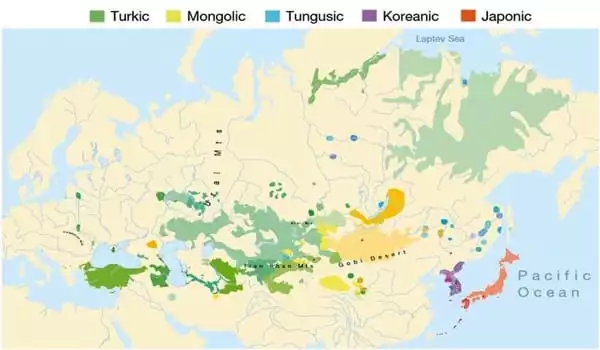The origin and early dispersion of speakers of Transeurasian languages, such as Japanese, Korean, Tungusic, Mongolic, and Turkic, is one of the most contentious issues in Eurasian population history. The relationship between linguistic dispersals, agricultural expansions, and population movements is a major issue.
New research lends interdisciplinary support to the ‘Farming Hypothesis’ of language dispersal, tracing Transeurasian languages back to the first farmers who moved across Northeast Asia in the Early Neolithic, roughly 8-10 thousand years ago.
The origin and early spread of Transeurasian languages, including Japanese, Korean, Tungusic, Mongolic, and Turkic, is one of the most contentious issues in Asian prehistory. Although many of the similarities between these languages are due to borrowing, recent research has found evidence to support the classification of Transeurasian as a genealogical group, or a group of languages that emerged from a common ancestor.
A new paper published in the journal Nature by an international team of researchers including researchers from the University of Auckland provides interdisciplinary support for the “Farming Hypothesis” of language dispersal, tracing Transeurasian languages back to the first farmers moving across Northeast Asia beginning in the Early Neolithic — roughly 8-10 thousand years ago.
The linguistic evidence for triangulation was derived from a new dataset of over 3,000 cognate sets representing over 250 concepts in nearly 100 Transeurasian languages. The findings show how humankind’s embrace of agriculture following the ice age fueled the spread of some of the world’s major language families.
The findings show how humankind’s embrace of agriculture following the ice age fueled the spread of some of the world’s major language families. As hunter-gatherers transitioned to an agricultural lifestyle, millet was an important early crop. Korean, Japanese, various Turkic languages in parts of Europe, Anatolia, Central Asia, and Siberia, various Mongolic languages, and various Tungusic languages in Manchuria and Siberia are among the 98 Transeurasian languages.
Using newly sequenced genomes, an extensive archaeological database, and a new dataset of vocabulary concepts for 98 languages, the researchers triangulate the time-depth, location, and dispersal routes of ancestral Transeurasian speech communities.
The evidence from linguistic, archeological, and genetic sources suggests that the Transeurasian languages can be traced back to the beginning of millet cultivation and the early Amur gene pool in the West Liao River region.
Millet farmers with Amur-related genes spread into contiguous regions across Northeast Asia during the Late Neolithic. Speakers of Proto-Transeurasian daughter branches admixed with Yellow River, western Eurasian, and Jomon populations over millennia, adding rice agriculture, western Eurasian crops, and pastoralist lifeways to the Transeurasian package.
The linguistic evidence for triangulation was derived from a new dataset of over 3,000 cognate sets representing over 250 concepts in nearly 100 Transeurasian languages. Researchers were able to construct a phylogenetic tree based on this data, which shows the roots of the Proto-Transeurasian family dating back over 9,000 years to millet farmers living in the West Liao River region.

The new study also includes the first collection of ancient genomes from Korea, the Ryukyu Islands, and early Japanese cereal farmers. By combining their findings with previously published East Asian genomes, the researchers discovered a common genetic component known as “Amur-like ancestry” among all speakers of Transeurasian languages.
They were also able to confirm that during the Bronze Age Yayoi period in Japan, massive migration from the continent occurred at the same time as farming was introduced. The study’s findings show that, despite millennia of extensive cultural interaction, Transeurasian languages share a common ancestor and that agriculture drove the early spread of Transeurasian speakers.
The tools, or phylogenetic methods, used in the study were largely developed by a team at the University of Auckland, according to Dr. Remco Bouckaert from the School of Computer Science. “I’ve been working on cultural evolution for a decade and am very pleased to see these quantitative techniques increasingly adapted and applied to research in the life sciences.”
Recent advances in ancient DNA sequencing have caused us to reconsider the links between human, linguistic, and cultural expansions across Eurasia. Eastern Eurasia, on the other hand, is still poorly understood in comparison to western Eurasia. Northeast Asia, which includes Inner Mongolia, the Yellow, Liao, and Amur River basins, the Russian Far East, the Korean peninsula, and the Japanese Islands, is particularly under-represented in recent literature.
The linguistic relatedness of the Transeurasian languages, also known as “Altaic,” is one of the most contentious issues in linguistic prehistory. The term transeurasian refers to a large group of geographically adjacent languages that span Europe and northern Asia and include five undisputed linguistic families: Japonic, Koreanic, Tungusic, Mongolic, and Turkic. The question of whether these five groups descended from a single common ancestor has long been a source of contention between proponents of inheritance and borrowing.
More ancient DNA, etymological research, and archaeobotanical research, according to the researchers, will deepen understanding of human migrations in Neolithic Northeast Asia and untangle the influence of later population movements, many of which were pastoralist in nature.
















